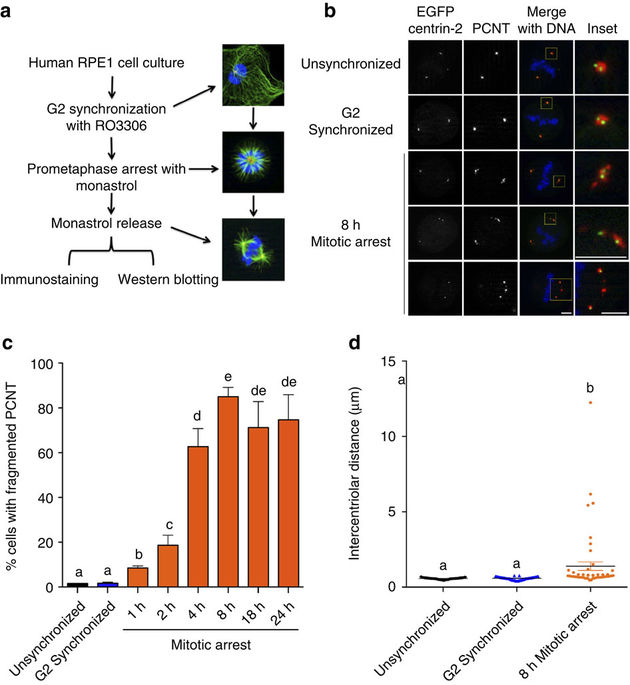当前位置:
X-MOL 学术
›
Nat. Commun.
›
论文详情
Our official English website, www.x-mol.net, welcomes your
feedback! (Note: you will need to create a separate account there.)
Precocious centriole disengagement and centrosome fragmentation induced by mitotic delay.
Nature Communications ( IF 14.7 ) Pub Date : 2017-06-13 , DOI: 10.1038/ncomms15803 Menuka Karki , Neda Keyhaninejad , Charles B. Shuster
Nature Communications ( IF 14.7 ) Pub Date : 2017-06-13 , DOI: 10.1038/ncomms15803 Menuka Karki , Neda Keyhaninejad , Charles B. Shuster

|
The spindle assembly checkpoint (SAC) delays mitotic progression until all sister chromatid pairs achieve bi-orientation, and while the SAC can maintain mitotic arrest for extended periods, moderate delays in mitotic progression have significant effects on the resulting daughter cells. Here we show that when retinal-pigmented epithelial (RPE1) cells experience mitotic delay, there is a time-dependent increase in centrosome fragmentation and centriole disengagement. While most cells with disengaged centrioles maintain spindle bipolarity, clustering of disengaged centrioles requires the kinesin-14, HSET. Centrosome fragmentation and precocious centriole disengagement depend on separase and anaphase-promoting complex/cyclosome (APC/C) activity, which also triggers the acquisition of distal appendage markers on daughter centrioles and the loss of procentriolar markers. Together, these results suggest that moderate delays in mitotic progression trigger the initiation of centriole licensing through centriole disengagement, at which point the ability to maintain spindle bipolarity becomes a function of HSET-mediated spindle pole clustering.
中文翻译:

由有丝分裂延迟引起的早熟中心粒脱离和中心体分裂。
纺锤体装配检查点(SAC)延迟有丝分裂进程,直到所有姊妹染色单体对都实现双向定向,并且SAC可以长时间保持有丝分裂阻滞,但有丝分裂进程的适度延迟会对所得子细胞产生重大影响。在这里,我们显示,当视网膜色素上皮细胞(RPE1)经历有丝分裂延迟时,中心体碎片和中心粒脱离会随时间增加。虽然大多数具有分离的中心粒的细胞保持纺锤体双极性,但分离的中心粒的簇集需要驱动蛋白14(HSET)。中心体碎片化和早熟中心粒脱离取决于分离酶和后期促进复合物/环体(APC / C)活性,这也触发了在子中心体上获取远端阑尾标志物,并丢失了中心体标志物。总之,这些结果表明,有丝分裂进程的中等延迟触发了通过中心粒脱离的中心粒许可的启动,此时,保持纺锤体双极性的能力成为HSET介导的纺锤体极簇的功能。
更新日期:2017-06-14
中文翻译:

由有丝分裂延迟引起的早熟中心粒脱离和中心体分裂。
纺锤体装配检查点(SAC)延迟有丝分裂进程,直到所有姊妹染色单体对都实现双向定向,并且SAC可以长时间保持有丝分裂阻滞,但有丝分裂进程的适度延迟会对所得子细胞产生重大影响。在这里,我们显示,当视网膜色素上皮细胞(RPE1)经历有丝分裂延迟时,中心体碎片和中心粒脱离会随时间增加。虽然大多数具有分离的中心粒的细胞保持纺锤体双极性,但分离的中心粒的簇集需要驱动蛋白14(HSET)。中心体碎片化和早熟中心粒脱离取决于分离酶和后期促进复合物/环体(APC / C)活性,这也触发了在子中心体上获取远端阑尾标志物,并丢失了中心体标志物。总之,这些结果表明,有丝分裂进程的中等延迟触发了通过中心粒脱离的中心粒许可的启动,此时,保持纺锤体双极性的能力成为HSET介导的纺锤体极簇的功能。


















































 京公网安备 11010802027423号
京公网安备 11010802027423号